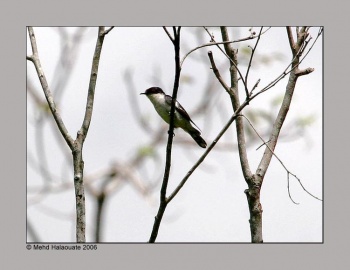- Chrysococcyx minutillus
Chalcites minutillus
Includes Gould's Bronze Cuckoo; Green-cheeked Bronze Cuckoo; Pied Bronze Cuckoo
Identification
15 - 16cm. A small cuckoo with some racial variation.
- Bronze-green upperparts
- White forehead and white above the eye
- Bright green crown
- Bronze green tail, sometimes washed rufous, barred black and white at sides, white tip with black end bar
- White underparts with blackish bars
- Red eyering, red eye
Variations
- peninsularis is darker-crowned, has white frosting on face and the females have a green eye-ring
- albifrons is whiter and less barred below
- cleis is slender-billed and more strongly barred below
- barnardi less glossy than nominate and with longer wings
- russatus bronze-green with rufescent tail and rufous underparts
- jungei with frosted brown and slightly glossed crown and back
- misoriensis more rufescent-bronze
- poecilurus with green upperparts without any rufous or bronze iridescence
- rufomerus with dark green upperparts and green cheeks
- salvadori with blue-black cheeks and no white above the eye and a small white wing patch
- crassirostris with green-glossed blackish blue upperparts and white wing patch
Females similar but with tan to yellow or white eyering and brown eye.
Juveniles are duller with grey-brown upperparts and white to rufous underparts with traces of barring on flanks.
Distribution

Photo © by mehdhalaouate
Yamdena Island, the Tanimbar, Indonesia, August 2006
From extreme southern Thailand to peninsular Malaysia and Singapore east to Sumatra, Java, Borneo, southern Philippines, over many Indonesian islands to New Guinea and northern Australia.
Locally common in Australia, scarce in the western part of its range. Some subspecies threatened due to habitat loss.
Taxonomy
This taxon includes Green-cheeked Bronze Cuckoo, Gould's Bronze Cuckoo and Pied Bronze Cuckoo, which are considered separate species by some authorities.
Subspecies
13 subspecies are listed, including one that has not been officially described yet:
- C. m. peninsularis from extreme southern Thailand to Peninsular Malaysia
- C. m. albifrons in northern Sumatra and western Java
- C. m. cleis in northern and eastern Borneo
- C. m. aheneus in southeast Borneo and southern Philippines
- C. m. jungei on Sulawesi, Madu and Flores
- C. m. rufomerus in the Lesser Sundas (Romang, Kisar, Leti, Moa, Sermata, Damar)
- C. m. crassirostris: "Pied Bronze-cuckoo". Moluccas (Tayandu, Kai Islands) and Tanimbar Island (Yamdena, Larat)
- C. m. salvadorii Tepa Island, only known from one specimen. This subspecies erroneously included in "Pied Bronze-cuckoo" based on an incorrect literature description (see [3])
- C. m. misoriensis in the lowlands on the northern coast of New Guinea and adjacent islands
- C. m. poecilurus in the lowlands on the southern coast of New Guinea and adjacent islands including Misool.
- C. m. minutillus in the Moluccas, Lesser Sundas and to northern Australia
- C. m. russatus in northern and eastern Queensland (Cape York along eastern coast)
- C. m. barnardi in eastern Australia (southeast Queensland to northeast New South Wales)
Birds on Timor belong to another, yet undescribed subspecies.
Subspecies crassirostris and salvadorii used to be split as Pied Bronze Cuckoo but are included here following Clements [1] and the IOC [4] (see notes under subspecies: this taxon is morphologically and vocally distinct). Little Bronze Cuckoo is sometimes placed in the genus Chalcites.
Habitat
Moist forest, including secondar growth and mangroves. Also in towns and gardens.
Usually found in dense lowland vegetation.
Found from sea-level up to 1400m, in New Guinea mainly up to 500m.
Behaviour
Diet
Feeds on insects, mainly on caterpillars, beetles and bugs.
Forages in the tree canopy.
Breeding
Breeding season from September to February in Queensland, November to March in Northern Territory, eggs reported in Malyasia in March and August. A brood parasitic. Know hosts are Golden-bellied Gerygone, Large-billed Gerygone and possibly also Rufous-sided Gerygone.
Movements
Northern subspecies resident, a partial migrant in Australia.
References
- Clements, J. F., T. S. Schulenberg, M. J. Iliff, S. M. Billerman, T. A. Fredericks, B. L. Sullivan, and C. L. Wood. 2019. The eBird/Clements Checklist of Birds of the World: v2019. Downloaded from http://www.birds.cornell.edu/clementschecklist/download/
- Del Hoyo, J, A Elliot, and J Sargatal, eds. 1997. Handbook of the Birds of the World. Volume 4: Sandgrouse to Cuckoos. Barcelona: Lynx Edicions. ISBN 978-8487334221
- Eaton, J.A.. van Balen, B. Brickle, N.W., B Rheindk F.E. (2021). Birds of the Indonesian Archipelago, Greater Sundas and Wallacea. Lynx Edicions. Barcelona. Second Edition
- Gill, F, D Donsker, and P Rasmussen (Eds). 2023. IOC World Bird List (v 13.2). Doi 10.14344/IOC.ML.13.2. http://www.worldbirdnames.org/
Recommended Citation
- BirdForum Opus contributors. (2024) Little Bronze Cuckoo. In: BirdForum, the forum for wild birds and birding. Retrieved 27 April 2024 from https://www.birdforum.net/opus/Little_Bronze_Cuckoo
External Links
GSearch checked for 2020 platform.1






